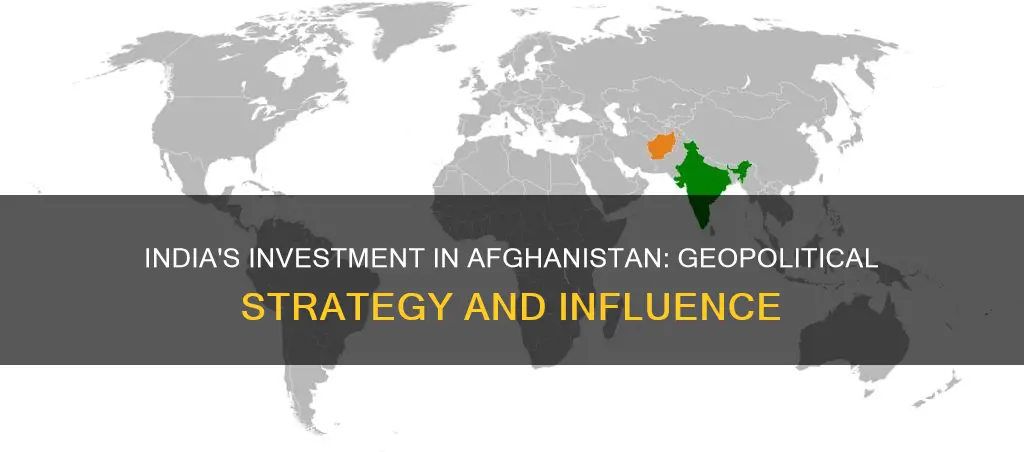
India has invested heavily in Afghanistan, spending around $3 billion on infrastructure projects and humanitarian assistance since the US toppled the Taliban regime in 2001. India's notable investments in Afghanistan include the Afghan parliament building in Kabul, the Salma Dam in Herat, and the Zaranj-Delaram highway, which connects India to Afghanistan through Iran's Chabahar port. India has also built schools and hospitals, trained Afghan officers in its military academies, and offered other technical assistance. The Indian government's goals in investing in Afghanistan include gaining public trust and political goodwill, limiting Pakistan's influence, and ensuring the country doesn't fall into the hands of the Taliban or become a security threat.
| Characteristics | Values |
|---|---|
| Total Investment | Over $3 billion |
| Time Period | 2001-2021 |
| Type of Investment | Infrastructure, Humanitarian Assistance, Development Aid |
| Examples of Projects | Salma Dam, Afghan Parliament, Stor Palace, Zaranj-Delaram Highway, Schools, Hospitals, Power Infrastructure, Transportation |
| Reasoning | To gain influence, limit Pakistan's influence, ensure a secure democratic regime, improve trade, and help rebuild Afghanistan |
What You'll Learn
- Investing in Afghanistan's infrastructure helps India limit Pakistan's influence
- India wants to ensure Afghanistan doesn't become a security threat
- India is committed to the political and democratic transformation of Afghanistan
- India wants to limit anti-India Islamist militant attacks
- Investing in Afghanistan is a gesture of good faith

Investing in Afghanistan's infrastructure helps India limit Pakistan's influence
Investing in Afghanistan's infrastructure has helped India limit Pakistan's influence in several ways. Firstly, by improving Afghanistan's infrastructure, India has gained an alternative trade route to Afghanistan that bypasses Pakistan. For example, India has invested in the Chabahar Port in Iran, which opens up an important route to Afghanistan while bypassing Pakistan. This is significant because Pakistan denies India overland access for trade with Afghanistan.
Secondly, India's investment in Afghanistan's infrastructure has helped to strengthen the relationship between the two countries, which may help to counter Pakistan's influence in the region. India's investments have been described as 'gifts' to the Afghan people, helping to foster political goodwill and gain public trust. This is in contrast to Pakistan, which has wielded influence over the Taliban, who are now in control of Afghanistan.
Thirdly, India's investment in Afghanistan's infrastructure has been accompanied by other forms of assistance, such as providing scholarships to Afghan students and training Afghan officers in its military academies. This has helped to strengthen Afghanistan's capacity and may have reduced its reliance on Pakistan.
Overall, India's investment in Afghanistan's infrastructure has been part of a broader strategy to limit Pakistan's influence in the region and strengthen its own position.
Explore Saving and Investment Options for Your Future
You may want to see also

India wants to ensure Afghanistan doesn't become a security threat
India has invested over $3 billion in Afghanistan, primarily in infrastructure projects such as roads, dams, and trade infrastructure. However, with the Taliban's swift takeover of Afghanistan, there are concerns about the future of these investments and whether they will amount to anything. One of India's primary goals in investing in Afghanistan was to ensure that the country did not fall into the hands of the Pakistan-supported Taliban, as this could pose a significant security threat to India.
India has a sizeable Muslim population and has survived several communal riots, with its Hindu nationalist Bharatiya Janata Party (BJP) government often accused of contributing to far-right violence through its populist rhetoric. The Taliban's takeover of Afghanistan has increased threats against India, with concerns that it could boost Islamist militants in the Kashmir region, which is disputed with Pakistan and has already seen two wars between the two countries. There are also fears that the Taliban could provide safe havens for anti-India terror groups such as Lashkar-e-Taiba (LeT) and Jaish-e-Mohammad (JeM), which have ties to Pakistan and have carried out attacks in India.
Additionally, the Taliban's close relationship with Al Qaeda, which has a presence in 10 out of Afghanistan's 34 provinces, poses a significant challenge to regional security. The Islamic State of Khorasan Province (ISKP), an affiliate of the Islamic State group, has also been carrying out attacks in the region and has criticised the Taliban's engagement with India. The Taliban's reluctance or inability to deal with these terror groups has led to closer counterterrorism cooperation between India and Russia.
To counter the security threat, India has taken a multi-pronged approach. This includes beefing up its counter-terror intelligence, conducting intelligence-led operations to neutralise terrorists, increasing vigilance along the Line of Control (LoC) to check infiltration and the smuggling of arms, and deploying more forces and technological surveillance in Eastern Ladakh. India has also called for more pressure on the Taliban to form an inclusive government and stop the harassment of ethnic and religious minorities, with Prime Minister Narendra Modi taking a firm stance on this issue at the G20 summit.
Understanding Simple Managed Investment Schemes: What You Need to Know
You may want to see also

India is committed to the political and democratic transformation of Afghanistan
India has been committed to the political and democratic transformation of Afghanistan for decades. In the 1980s, India was the only South Asian country to recognize the Soviet-backed Democratic Republic of Afghanistan. India also supported the overthrow of the Taliban in the early 2000s and became the largest regional provider of humanitarian and reconstruction aid to the former Islamic Republic of Afghanistan.
Since then, India has invested over $3 billion in Afghanistan, making it one of the largest regional donors to the country. These investments have taken the form of infrastructure projects, such as roads, dams, and the new Afghan Parliament building, as well as development assistance in the form of scholarships, schools, and hospitals.
In a letter delivered by Indian Foreign Secretary Harsh Shringla to Afghan President Ashraf Ghani, Indian Prime Minister Narendra Modi pledged support to Ghani to fight terrorism in the region and reiterated India's commitment to a "unified, sovereign, democratic, prosperous, and peaceful" Afghanistan.
India's commitment to Afghanistan's political and democratic transformation is also evident in its efforts to strengthen diplomatic relations between the two countries. In 2011, Afghanistan and India signed a strategic partnership agreement, Afghanistan's first since the Soviet-Afghan War. Additionally, India has sought to improve regional connectivity through trade, energy, and investment, with Afghanistan serving as a crucial link between South and Central Asia.
However, with the Taliban's swift takeover of Afghanistan following the US withdrawal, the future of India's investments and efforts to support Afghanistan's political and democratic transformation remains uncertain.
NRIs in India: Home Prices and Investment Impact
You may want to see also

India wants to limit anti-India Islamist militant attacks
India has been investing in Afghanistan to limit anti-India Islamist militant attacks. The country has been a target of terrorism for over a decade, with Islamist terrorism being one of the most prominent forms of terrorism in the country. Terrorist attacks have hit the Indian Parliament, the historic Red Fort in Delhi, and Kashmir's state assembly.
The Indian government has been concerned about the possibility of Islamist militant organisations using Afghanistan as a base to launch attacks on India. This concern has been heightened by the presence of rival Pakistan, which has influence over the Taliban and has historically sponsored militant groups in the region. India's investment in Afghanistan is aimed at countering Pakistan's influence and ensuring that the country does not become a safe haven for militants.
India has invested in Afghanistan's infrastructure, including the Salma Dam and the new Afghan Parliament, as well as other projects such as roads, schools, and hospitals. These investments are intended to strengthen the Afghan government and improve the lives of Afghans, thereby reducing the appeal of Islamist militancy.
Additionally, India has also invested in Afghanistan's security apparatus, particularly in the National Directorate of Security (NDS). However, with the Taliban's takeover of Afghanistan, the future of these investments is uncertain. India now faces the challenge of engaging with the Taliban to protect its investments and limit the threat of anti-India Islamist militant attacks.
Knowledge Management: A Smart Investment for Future Success
You may want to see also

Investing in Afghanistan is a gesture of good faith
India's investments in Afghanistan are not just limited to infrastructure. The country has also provided development assistance, with projects across the country in all 34 of Afghanistan's provinces. These projects include building roads, dams, electricity transmission lines and substations, schools, and hospitals. India has also assisted in the reconstruction of power infrastructure, such as the 220kV DC transmission line from Pul-e-Khumri to Kabul, and has provided humanitarian assistance in the form of medical care and education.
India's investments in Afghanistan are also aimed at gaining political goodwill and ensuring the country does not fall into the hands of the Pakistan-supported Taliban. India has a sizeable Muslim population and shares a border with Afghanistan, so it is crucial for India to ensure that anti-India Islamist militants do not launch attacks on Indian soil from Afghanistan.
By investing in Afghanistan, India is also hoping to limit Pakistan's influence in the region and gain a strategic foothold in a geographically important location. Afghanistan is landlocked, and Pakistan does not allow India to transport goods to Afghanistan across its territory. Therefore, India has invested in alternative trade routes, such as the Chabahar port in Iran and the Delaram-Zaranj highway, to facilitate trade with Afghanistan.
Overall, India's investments in Afghanistan are a combination of soft and hard power, with the goal of achieving political and economic benefits while also demonstrating good faith and providing much-needed assistance to a war-torn country.
Retirement Investing: Strategies for Indians to Grow Their Wealth
You may want to see also
Frequently asked questions
India has invested in Afghanistan to ensure the country aligns with New Delhi's interests instead of those of its rival, Pakistan.
India has invested over $3 billion in Afghanistan, making it one of the largest regional donors to the country.
India has invested in key infrastructure projects, including roads, dams, schools, hospitals, and the new Afghan parliament building.
The future of India's investments in Afghanistan is uncertain following the Taliban's return to power. India is in a "wait and watch" mode as it assesses the situation.







